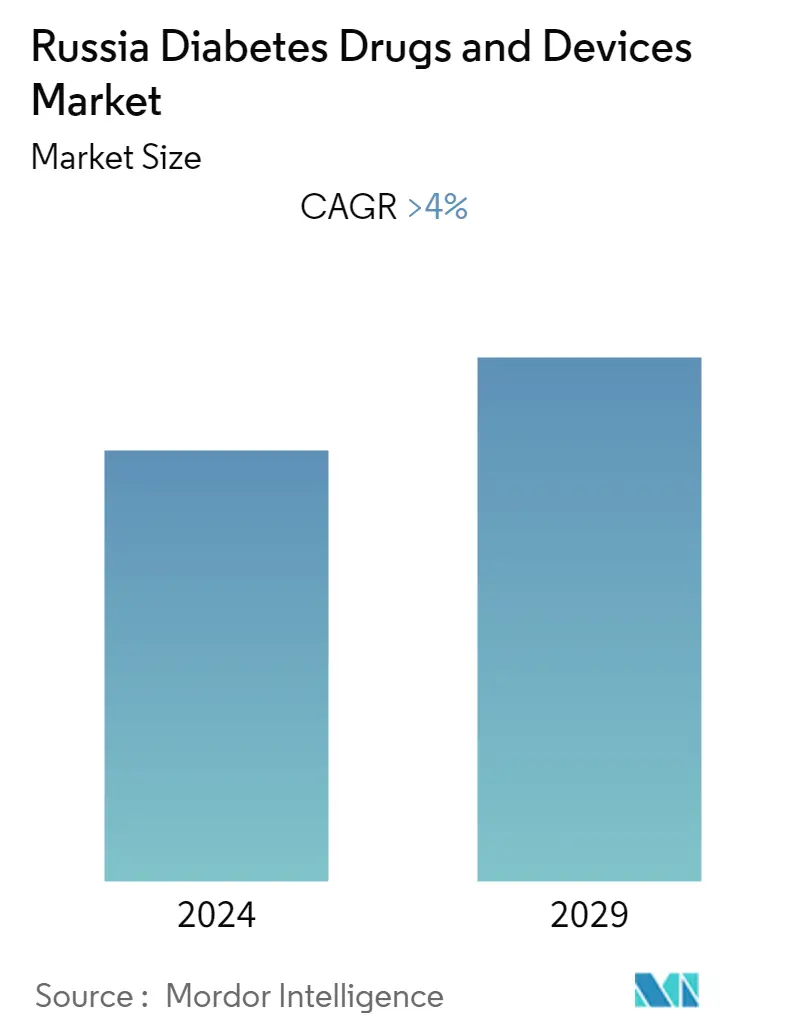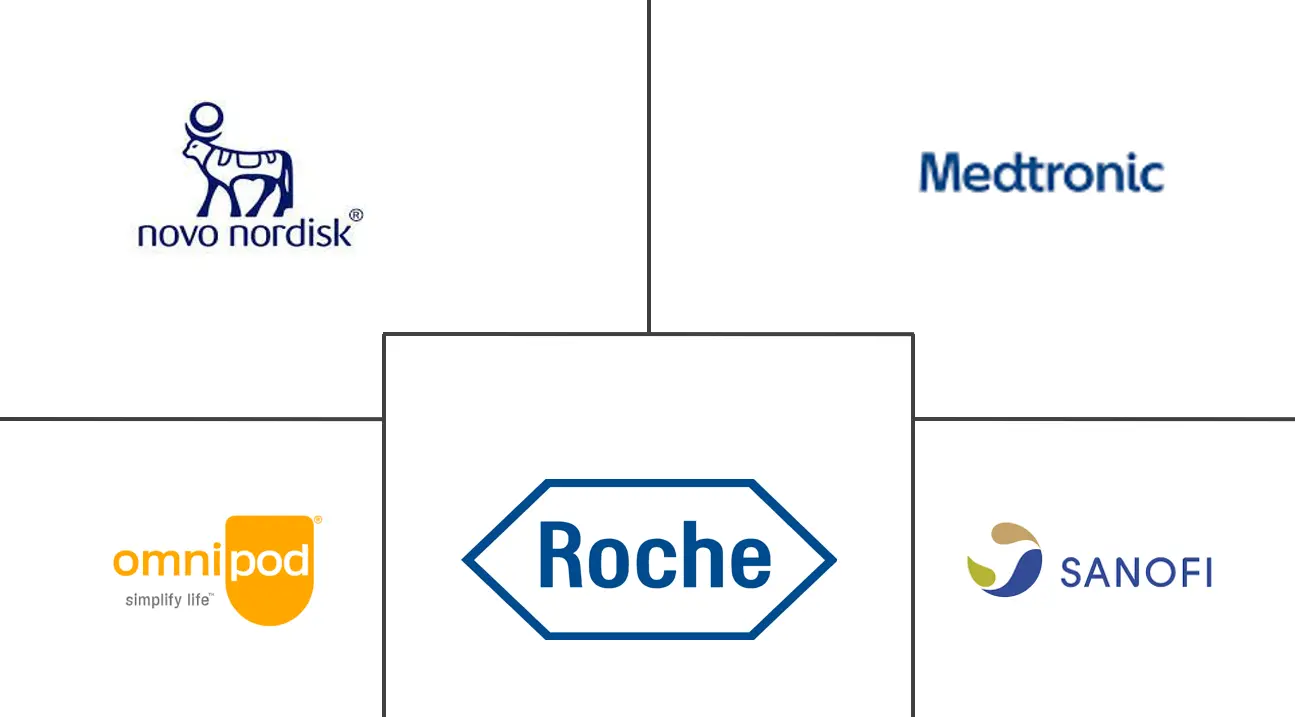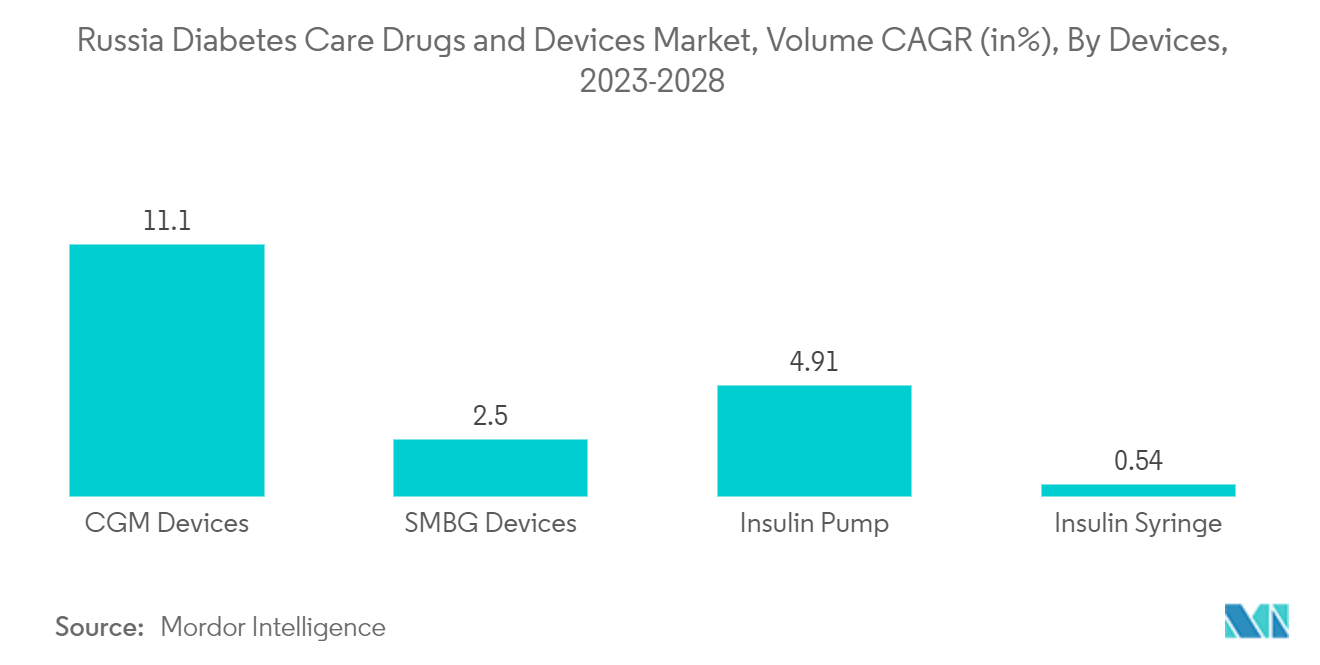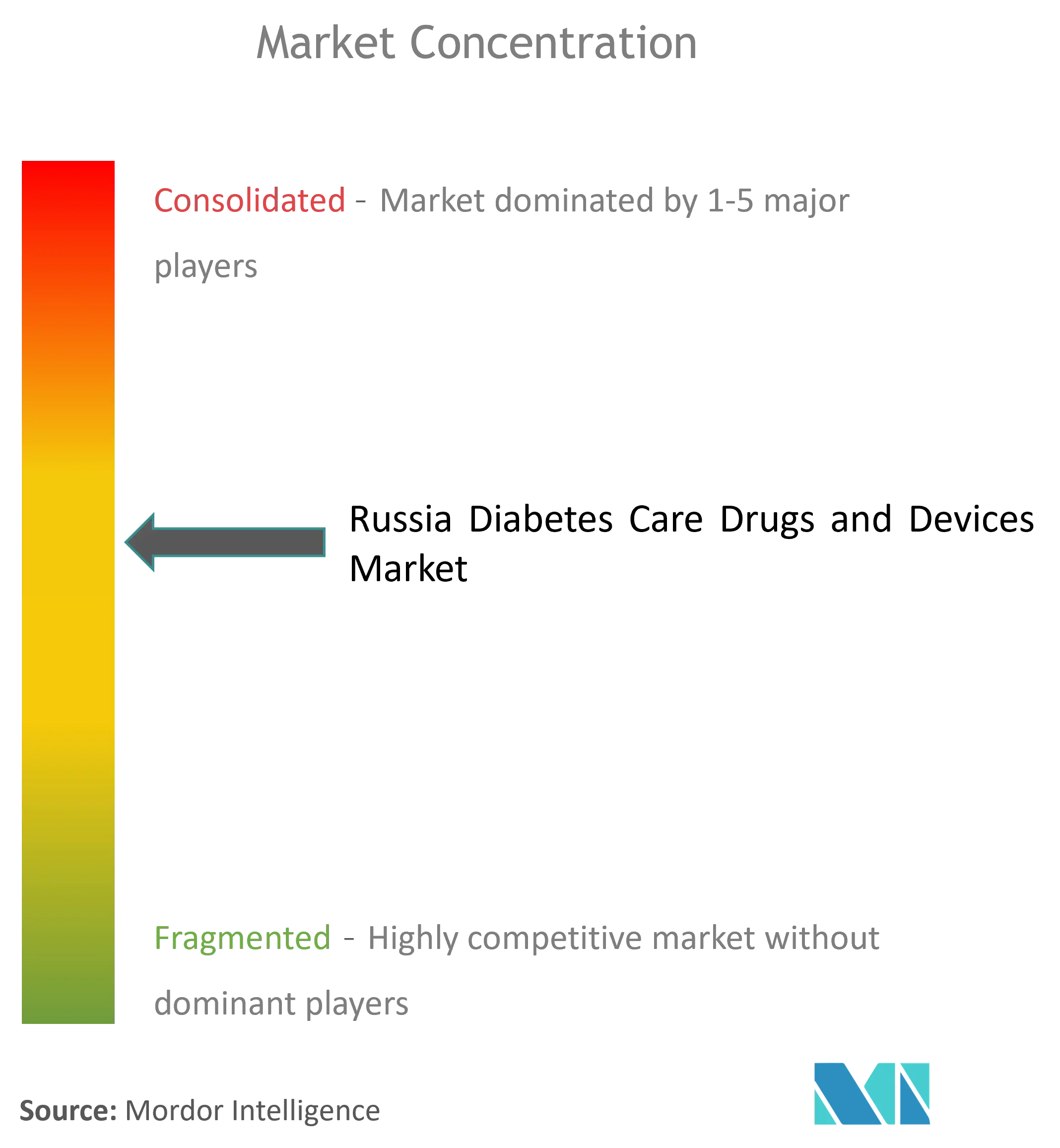Russia Diabetes Drugs and Devices Market Size

| Study Period | 2018 - 2029 |
| Base Year For Estimation | 2023 |
| Forecast Data Period | 2024 - 2029 |
| Historical Data Period | 2018 - 2022 |
| CAGR | > 4.00 % |
Major Players
*Disclaimer: Major Players sorted in no particular order |
Russia Diabetes Drugs and Devices Market Analysis
Russian diabetes drugs and devices market is estimated at USD 2.2 billion in the current year. The market is expected to reach USD 2.7 billion in five years, at a CAGR of more than 4% during the forecast period.
A year into the COVID-19 pandemic, it caused premature deaths, especially among the elderly. Russia has the ninth-highest number of coronavirus cases in the world. Most people who die from COVID-19 are affected by having two or more chronic conditions in the same person. Several studies have confirmed that chronic conditions such as diabetes are associated with undesirable outcomes in COVID-19 patients. Diabetes drugs are designed to stabilize and control blood sugar levels in people with diabetes. Antidiabetic drugs have become potential candidates for treating diabetic patients affected by SARS-CoV-2 infection during the novel coronavirus disease (COVID-19) pandemic. Rapid increases in the incidence and prevalence of diabetes and healthcare costs indicate increased use of diabetes care products. According to Roscongress, Russia ranks fifth in the world in terms of the number of people with diabetes between the ages of 20 and 79. In addition, the death rate among people with diabetes increased by 22% during the COVID-19 pandemic.
An increasing rate of new diagnoses of type 1 and type 2 diabetes has been observed, mainly due to obesity, unhealthy diet, and lack of exercise. Rapid increases in the incidence and prevalence of diabetes and healthcare costs indicate increased use of diabetes care products. In May 2021, the World Health Assembly agreed to a resolution to strengthen diabetes prevention and control. Action is recommended in the following areas: Improving access to insulin. Facilitate consolidating and harmonising regulatory requirements for insulin and other drugs and healthcare products used to treat diabetes. Evaluate the feasibility and potential value of establishing a web-based tool for sharing information related to transparency in the diabetes drug and healthcare products market.
Therefore, owing to the aforementioned factors, the studied market is anticipated to grow over the analysis period.
Russia Diabetes Drugs and Devices Market Trends
The continuous Glucose Monitoring Segment is Expected to Witness the Highest Growth Rate Over the Forecast Period
The continuous blood glucose monitoring segment is expected to register a CAGR of around 15.05% during the forecast period.
A continuous blood glucose monitor is an automatic blood glucose monitoring system consisting of a small device worn on the body and attached with an adhesive patch. The sensor portion of the device includes a cannula inserted into the top layer of the skin and uses a sample of interstitial fluid to check blood sugar levels. The sensor is connected to a transmitter that can transmit data wirelessly to a particular mobile receiving device or smartphone. For diabetics, their caregivers, and the community, her use of CGM is beneficial in managing blood sugar and insulin levels to maintain good health. CGM makes blood sugar control much more accessible by reducing interruptions and allowing for better sleep. It also improves the mental health of patients and caregivers by reducing the overall mental burden associated with diabetes management.
Continuous blood glucose monitoring has become a popular alternative to commercially available portable finger glucose meters for people with diabetes. The sensor is the most important part of any continuous blood glucose monitoring device. Various promising glucose sensor technologies are being developed, ranging from traditional electrochemical glucose sensors to new optical and other electrical glucose sensors, positively impacting the market growth. Continuous blood glucose monitoring sensors have opened new scenarios for offline assessment of the efficacy of treatment regimens for individual patients, facilitating the development of innovative online applications. This includes a hypoglycemia\/hyperglycemia warning system and an artificial pancreas control algorithm. With new technologies, continuous blood glucose monitoring devices are becoming increasingly inexpensive.
Market opportunities for players in the Russian diabetes drugs and devices market include numerous new product launches, increased international research collaboration for technological advances, and increased public awareness of diabetes.

Rising diabetes prevalence
There has been an alarming increase in the prevalence of diabetes in Russia in recent years. A diabetic need several corrections throughout her day to maintain nominal blood sugar levels, including Oral antidiabetic drugs, or monitor blood sugar and take additional carbohydrates. It has been observed that the rate of new diagnoses of type 1 and type 2 diabetes is increasing, mainly due to obesity, unhealthy diet, and lack of exercise.
Various efforts have been started to fight diabetes in Russia. For example, at the 2021 Moscow City Forum, a memorandum of understanding was signed between the Youth Council of the Ministry of Health of Moscow, the Moscow City Forum, the Moscow Diabetes Association, the Medical Department of the Moscow Diabetes Association, KB Strelka, and Novo. Nordisk implements Urban Modified Diabetes Program in Moscow. The Moscow program aims to comprehensively assess the characteristics of diabetes challenges relevant to Moscow. The program has also developed an action plan to combat the disease in the most vulnerable populations.
According to the IDF, the Russian government needs to fully implement the National Diabetes Plan to stem the spread of diabetes in the country. This plan provides a state budget to ensure diabetes treatment for all Russian citizens. Russia is working to improve its reimbursement system for all aspects of diabetes care to limit out-of-pocket costs and prevent devastating household expenditures. In addition, a national screening program for improved early detection of carbohydrate metabolism disorders was introduced, and a specialized diabetes health service was established under the Ministry of Health of the Russian Federation.
The increasing diabetes prevalence and the above factors will likely drive the segment growth over the forecast period.

Russia Diabetes Drugs and Devices Industry Overview
Manufacturers have constantly innovated to survive in the market. Large companies such as Abbott and Medtronic have made numerous mergers, acquisitions, and partnerships to gain market dominance while adhering to organic growth strategies. The manufacturers of insulin delivery devices are spending a huge amount on the R&D of the devices. For example, Novo Nordisk partnered with Abbott Diabetes Care, which may also assist to enable insulin statistics to be shared between Novo Nordisk-connected insulin pens and digital fitness equipment well suited to the FreeStyle Libre portfolio of products.
Russia Diabetes Drugs and Devices Market Leaders
-
Medtronics
-
Roche
-
NovoNordisk
-
Sanofi
-
Omnipod
*Disclaimer: Major Players sorted in no particular order

Russia Diabetes Drugs and Devices Market News
- February 2023: AstraZeneca's Forxiga (dapagliflozin) was approved in the European Union to extend the indication for heart failure with reduced ejection fraction to cover patients across the full spectrum of left ventricular ejection fraction. It includes heart failure with mildly reduced and preserved ejection fraction.
- February 2023: Medtronic PLC announced one-year data from the ADAPT study, the first multi-national randomized controlled study comparing the MiniMed 780G advanced hybrid closed loop system (AHCL) performance against multiple daily injections of insulin with an intermittently scanned CGM. The study was done in adults (18 years and older) who did not meet glycemic targets. At one year, significant improvements were reproduced in this cross-over group and sustained in those who started AHCL therapy at the start of the trial.
Table of Contents
1. INTRODUCTION
1.1 Study Assumptions and Market Definition
1.2 Scope of the Study
2. RESEARCH METHODOLOGY
3. EXECUTIVE SUMMARY
4. MARKET DYNAMICS
4.1 Market Overview
4.2 Market Dynamics
4.2.1 Market Drivers
4.2.2 Market Restraints
4.3 Porter's Five Forces Analysis
4.3.1 Bargaining Power of Suppliers
4.3.2 Bargaining Power of Consumers
4.3.3 Threat of New Entrants
4.3.4 Threat of Substitute Products and Services
4.3.5 Intensity of Competitive Rivalry
5. Market Segmentation (Market Size by Value - USD)
5.1 Devices
5.1.1 Monitoring Devices
5.1.1.1 Self-monitoring Blood Glucose Devices
5.1.1.2 Continuous Blood Glucose Monitoring
5.1.2 Management Devices
5.1.2.1 Insulin Pump
5.1.2.2 Insulin Syringes
5.1.2.3 Insulin Cartridges
5.1.2.4 Disposable Pens
5.2 Drugs
5.2.1 Oral Anti-Diabetes Drugs
5.2.2 Insulin Drugs
5.2.3 Combination Drugs
5.2.4 Non-Insulin Injectable Drugs
6. Market Indicators
6.1 Type-1 Diabetes Population
6.2 Type-2 Diabetes Population
7. COMPETITIVE LANDSCAPE
7.1 Company Profiles
7.1.1 Novo Nordisk
7.1.2 Medtronic
7.1.3 Insulet
7.1.4 Tandem
7.1.5 Ypsomed
7.1.6 Novartis
7.1.7 Sanofi
7.1.8 Eli Lilly
7.1.9 Abbottt
7.1.10 Roche
7.1.11 Astrazeneca
7.1.12 Dexcom
7.1.13 Pfizer
- *List Not Exhaustive
7.2 Company Share Analysis
8. MARKET OPPORTUNITIES AND FUTURE TRENDS
Russia Diabetes Drugs and Devices Industry Segmentation
Patients with type 1 diabetes must be given insulin because their pancreas cannot process it. To control blood sugar levels, insulin must be given several times daily, such as when eating or drinking. Many people with type 2 diabetes also need to take antidiabetic drugs. These drugs include diabetes medications and injections, such as insulin. The Russia diabetes drugs and devices market is segmented by drugs (insulin, oral anti-diabetic drugs, non-insulin injectable drugs, and combination drugs), and devices (management devices such as insulin pumps, insulin pens, syringes, cartridges, and jet injectors, and monitoring devices including self-monitoring blood and continuous glucose monitoring). The report offers the value (in USD) and volume (in unit) for the above segments.
| Devices | ||||||
| ||||||
|
| Drugs | |
| Oral Anti-Diabetes Drugs | |
| Insulin Drugs | |
| Combination Drugs | |
| Non-Insulin Injectable Drugs |
Frequently Asked Questions
What is the current Russia Diabetes Drugs and Devices Market size?
The Russia Diabetes Drugs and Devices Market is projected to register a CAGR of greater than 4% during the forecast period (2024-2029)
Who are the key players in Russia Diabetes Drugs and Devices Market?
Medtronics, Roche, NovoNordisk, Sanofi and Omnipod are the major companies operating in the Russia Diabetes Drugs and Devices Market.
What years does this Russia Diabetes Drugs and Devices Market cover?
The report covers the Russia Diabetes Drugs and Devices Market historical market size for years: 2018, 2019, 2020, 2021, 2022 and 2023. The report also forecasts the Russia Diabetes Drugs and Devices Market size for years: 2024, 2025, 2026, 2027, 2028 and 2029.
Russia Diabetes Drugs and Devices Industry Report
Statistics for the 2024 Russia Diabetes Drugs and Devices market share, size and revenue growth rate, created by Mordor Intelligence™ Industry Reports. Russia Diabetes Drugs and Devices analysis includes a market forecast outlook to for 2024 to 2029 and historical overview. Get a sample of this industry analysis as a free report PDF download.



